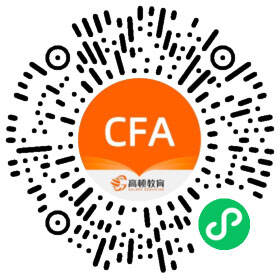
报考指南:2014年CFA考试备考指南
免费题库:2014年CFA免费题库
考前冲刺:CFA考试备考专题
高清网课:CFA考试网络课程



1、凡本网站注明“来源高顿教育”或“来源高顿网校”或“来源高顿”,的所有作品,均为本网站合法拥有版权的作品,未经本网站授权,任何媒体、网站、个人不得转载、链接、转帖或以其他方式使用。
2、经本网站合法授权的,应在授权范围内使用,且使用时必须注明“来源高顿网校”或“来源高顿”,并不得对作品中出现的“高顿”字样进行删减、替换等。违反上述声明者,本网站将依法追究其法律责任。
3、本网站的部分资料转载自互联网,均尽力标明作者和出处。本网站转载的目的在于传递更多信息,并不意味着赞同其观点或证实其描述,本网站不对其真实性负责。
4、如您认为本网站刊载作品涉及版权等问题,请与本网站联系(邮箱fawu@gaodun.com,电话:021-31587497),本网站核实确认后会尽快予以处理。
2024年考CFA一级可以从事哪些工作,那么无论何时考取CFA证书都是值得期待的。那么考了CFA之后能从事哪些工作?金融分析师的题型又有哪些呢,下面请跟随...
2023-09-302024年5月CFA一级考试据说发生了很大的变化,变化程度超过了50%!究竟怎么一回事儿呢,今天学姐就来好好跟大家聊聊这个话题,一起来看看吧~...
2023-10-02老师 为什么第二题不做处理呢 不应该计入资本公积—股本溢价吗
老师好,这道题的会计分录应该是这样的吧,但是我不理解其他综合收益2000那个步骤,他不是以摊余成本计量的金融资产已确认损失2000万吗?不应该是信用减值损失的科目吗?为什么写其他综合收益这个科目在这里?
老师您好,固定资产清理,卖掉时候,转银行存款和资产处置损益,差别在哪里呢。我觉得卖掉固定资产,转哪个都差不多啊,谢谢老师。
选项c,资本公积—股本溢价4500为什么不选?
收回前期已核销的坏账,坏账准备记录在贷方怎么理解
老师 为什么第二题不做处理呢 不应该计入资本公积—股本溢价吗
老师好,这道题的会计分录应该是这样的吧,但是我不理解其他综合收益2000那个步骤,他不是以摊余成本计量的金融资产已确认损失2000万吗?不应该是信用减值损失的科目吗?为什么写其他综合收益这个科目在这里?
老师您好,固定资产清理,卖掉时候,转银行存款和资产处置损益,差别在哪里呢。我觉得卖掉固定资产,转哪个都差不多啊,谢谢老师。
选项c,资本公积—股本溢价4500为什么不选?
收回前期已核销的坏账,坏账准备记录在贷方怎么理解
cfa一级官方建议备考时间是多久?最近有准备报考CFA一级的小伙伴咨询到学姐这个问题,今天学姐就来一一为大家进行解答,下面请跟随学姐一起来看看吧~...
2023-09-01一级CFA考试内容是什么样的,考试科目包含哪些?最近有同学咨询到学姐这个问题,今天学姐就来好好为大家进行解答,一起来看看吧~...
2023-09-012024年重庆CFA一级准考证如何打印?最近有同学咨询到小编这个话题,今天学姐就来统一为大家进行解答,下面请跟随学姐一起来看看吧~...
2023-08-24cfa一级全是选择题吗?最近有同学咨询到学姐这个问题,今天小编就来好好跟大家聊聊关于CFA一级考试的那些事儿,下面请跟随学姐一起来看看吧~...
2023-08-15马上就要进行11月CFA考试的,最近有很多小伙伴咨询到小编关于cfa一级课程安排是怎么样的?考试该如何搭配学习?今天学姐就来统一为大家进行解答,一起来看看吧~...
2023-08-15cfa一级备考一般要多久?要看哪些资料?CFA一级考试为CFA考试中的入门级别考试,涉及到4000多个金融知识点,考试的科目有10门,如果考生想要一次性通过CFA一级考试,也要注意投入充分的备考时间。今天学姐就来详细的跟大家聊聊关于CFA一级复习资料那些事儿,一起来看看吧~...
2023-08-08